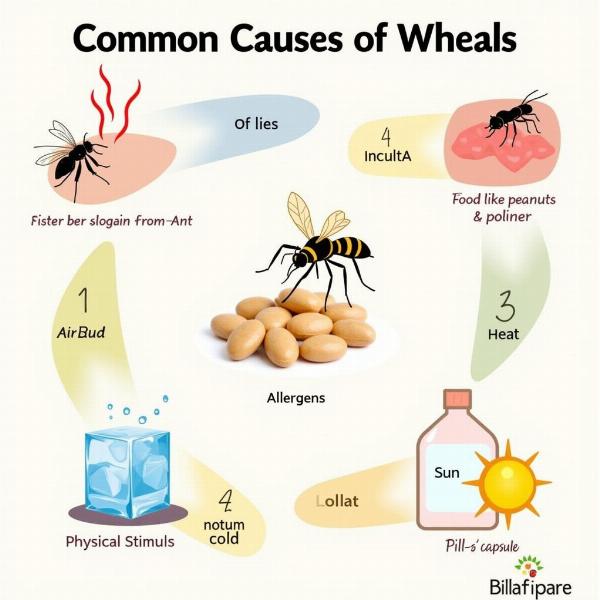Understanding the meaning of “wheal” in Hindi can be tricky, especially given the nuances of both languages. This guide aims to provide a clear and comprehensive understanding of the term, covering its various meanings, contexts, and related terminology. We’ll explore its medical, agricultural, and even historical connotations, ensuring you gain a complete grasp of “wheal meaning in Hindi.”
Understanding “Wheal” in Different Contexts
“Wheal” doesn’t have a single, direct equivalent in Hindi. Its meaning varies depending on the context. Let’s delve into the most common interpretations:
-
Medical Context: In medicine, a wheal refers to a raised, itchy bump on the skin, often caused by an allergic reaction or insect bite. The closest Hindi translations are फुंसी (phunsi) meaning pimple or boil, or दाना (daana), which refers to a rash or eruption. However, these terms don’t fully capture the specific nature of a wheal. A more precise term might be त्वचा प्रतिक्रिया (tvacha pratikriya) meaning skin reaction, often followed by a descriptive term like उभरा हुआ (ubhara hua) meaning raised or swollen.
-
Agricultural Context: In agriculture, a wheal can refer to a raised ridge or welt on the skin of a plant or animal. In this context, गांठ (ganth) meaning knot or lump could be used. However, depending on the specific plant or animal, more specific terms might exist.
-
Historical Context: Historically, “wheal” has also been used to refer to a mark left by a whip or lash. While less common today, the closest Hindi equivalent would be चाबुक का निशान (chabuk ka nishan), meaning a whip’s mark.
Wheal in Medical Terminology: A Closer Look
The medical context of “wheal” is perhaps the most frequently encountered. It’s crucial to understand its characteristics and causes. Wheals are typically temporary, appearing suddenly and often disappearing within a few hours. They can be caused by various factors, including:
- Insect Bites: Mosquitoes, bees, wasps, and ants are common culprits.
- Allergies: Allergic reactions to food, medications, or environmental factors can trigger wheals.
- Physical Stimuli: Pressure, cold, heat, or even sunlight can cause wheals in some individuals.
- Underlying Medical Conditions: In rare cases, wheals can be a symptom of a more serious underlying medical condition.
 Common Causes of Wheals
Common Causes of Wheals
Identifying and Treating Wheals
Identifying a wheal is relatively straightforward. Look for a raised, reddish bump that is often itchy. The size and shape can vary. Treatment usually involves addressing the underlying cause, such as avoiding allergens or treating insect bites. Over-the-counter antihistamines can help relieve itching.
When to Seek Medical Attention
While most wheals are harmless and resolve on their own, there are instances where medical attention is necessary. Seek immediate medical help if the wheals:
- Are accompanied by difficulty breathing or swallowing.
- Spread rapidly over the body.
- Occur alongside dizziness or lightheadedness.
- Appear after taking a new medication.
Conclusion: Understanding “Wheal” in Hindi
Understanding the meaning of “wheal” in Hindi requires context. While there isn’t a single perfect translation, using terms like फुंसी (phunsi), दाना (daana), or त्वचा प्रतिक्रिया (tvacha pratikriya) can help convey the intended meaning depending on the situation. Knowing the different interpretations of “wheal” across medical, agricultural, and historical contexts enhances your understanding of the term in Hindi.
FAQ
- What is the most accurate Hindi translation for “wheal”? There isn’t one single perfect translation. The closest term depends on the context.
- Are wheals dangerous? Most wheals are harmless and resolve on their own. However, severe reactions require medical attention.
- How can I treat wheals at home? Over-the-counter antihistamines can relieve itching. Avoiding triggers is key.
- When should I see a doctor for wheals? Seek medical attention if you experience difficulty breathing, swelling, or dizziness along with wheals.
- Can stress cause wheals? Stress can exacerbate existing skin conditions, potentially worsening wheal symptoms.
- What is the difference between a wheal and a hive? Hives are a type of wheal, specifically related to allergic reactions.
- Are wheals contagious? Wheals themselves are not contagious.
Meaning-Hindi.in offers professional translation services in various domains, including medical, legal, technical, and business. Our expert linguists ensure accurate and culturally sensitive translations, bridging the language gap for seamless communication. Whether you need document translation, website localization, or interpretation services, we provide tailored solutions to meet your specific needs. Contact us today for a free quote at [email protected] or call us at +91 11-4502-7584. Meaning-Hindi.in is your trusted partner for all your Hindi translation requirements.